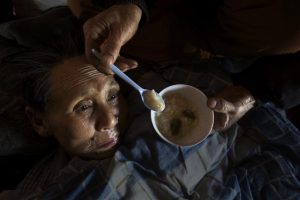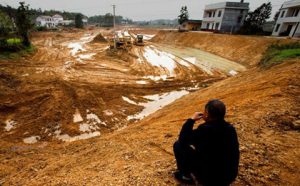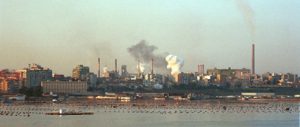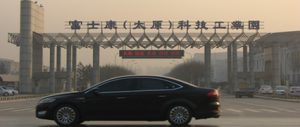The geography of industrialisation and pollution is uneven – people's level of exposure to pollution varies both globally and within countries.
Marginalised communities are often particularly affected, and this can be the result of deliberate choices by governments and industries. For example, the notorious 1984 Cerrell Report, commissioned by officials in California, advised firms in the United States that they could avoid or overcome opposition to the siting of facilities by locating them in poor, relatively uneducated, rural and ethnic minority communities.
In the US, these divisions often follow racial lines, giving rise to “environmental racism”, a term which became widely known with the publication of Dumping in Dixie, by Robert Bullard. It refers to biased policies and practices which result in inequalities in the built environment whereby toxins and other hazardous waste and pollutants concentrate in low-income ethnic minority communities. Several maps illustrate these inequalities clearly. A map of Los Angeles County (see below), for instance, shows the correlation between toxic facilities and ethnic minority areas. In these areas the ailments which result from pollution, such as asthma, are particularly frequent.
One of the most infamous cases of environmental racism is Louisiana’s “cancer alley”, a stretch of the Mississippi river between Baton Rouge and New Orleans covered with chemical plants, plastic plants, fertiliser manufacturers, electrical power plants, and oil refineries (Barbara Allen and Steve Lerner have both written books on this region). This area became a prime setting for the petrochemical industry. There are 135 plants along 85 miles of the Mississippi, producing over one-fifth of US petrochemicals. The name 'cancer alley' was coined by activists in the 1980s to suggest that the toxins that are being released by the plants have led to an extremely high rate of cancer (childhood cancers in particular) among locals.
While poor black communities are disproportionately affected by pollution, they do not put up with its effects in silence. The Cerrell report assumed that marginalised communities would prioritise earning a living over fighting pollution, and therefore they would not complain for fear of losing their jobs in the local industries. To some extent this is true. But the dynamics of such scenarios are also more complex: the social, cultural and political texture of communities affects their willingness and their capacity to complain and to do so effectively. Access to information necessary to make a case to the relevant company or to higher authorities that pollution affects a community’s health is also a key hurdle, which tends to be bigger among those who are socially, politically and economically marginal. More often than not, when polluting firms are in the spotlight, they emphasise the role of genes, diet and lifestyle in disease causation over the role of pollutants, or stress that the latter alone cannot be blamed.
Of course, the underlying problem is that it is scientifically very hard to determine what causes illness. Is cancer caused by smoking and fatty diets? Or by pollution? The answer is extremely complex. And as a consequence there is vast disagreement about what might be blamed. The politics of blaming behaviour or genes, instead of pollution, serve to maintain the legitimacy of both state and industry instead of questioning inequality.
Citizens, sometimes in collaboration with scientists, have increasingly taken a stand against this injustice. This growing and fascinating field is often called ‘citizen science’, to recognise the important role that citizens play in scientific debates (including those over the siting of polluting industries), in challenging the status quo, and pushing science to redefine its boundaries. In many cases, having lost trust in official channels for pollution monitoring, citizens have strived to take science into their own hands. “Bucket brigades” for instance first emerged in the US among communities which used relatively simple technologies to monitor air pollution independently and used their data to demand stricter regulation.
China's marginalised victims
In China, similar processes seem to be at play – socio-economic differences are reflected in uneven power and capacity to gather knowledge that could serve as evidence of pollution’s harm and to mobilise effectively. In recent years, urban middle class homeowner protests against pollution, such as those in Shifang, Qidong and Ningbo in 2012, have become increasingly visible and adopted citizen science-style strategies. By contrast, countless villages are suffering from pollution without being able to gain attention, let alone redress. Rural environmentalism typically takes place far from the legal system, the media and NGOs (which are often studied as key forces in the rise of environmentalism) and rests more firmly on direct appeals to local officials, polluting firms and small protests.
There are of course exceptions. 2013 saw a spike in reports on “cancer villages”, clusters of high cancer incidence, following the publication of a ministry of environmental protection document which acknowledged their existence. There too, local residents attempted to gather data – including cancer name lists, documenting the severity of pollution through pictures and collaboration with campaigners, and demanding release of official data – to put pressure on companies to clean up. The NGO Huai River Warriors founded by former journalist Huo Daishan to document and combat pollution in the Huai River Basin and the case of Qiugang village (Anhui), portrayed in the documentary The Warriors of Qiugang, are two such examples. These cases however remain in the minority.
The emergence of advocacy coalitions between rural and urban activists gives some grounds for hope. In 2013 I carried out some research with colleagues Dr Thomas Johnson and Dr Jixia Lu on rural resistance to waste incinerators. We visited the village of Panguanying in Hebei, which potentially presents a breakthrough for rural environmental justice: three villagers have taken the lead in opposing the construction of a local incinerator and, so far, they been able to halt it. Much of their success is owed to their ability to team up with campaigners in Beijing from Green Beagle and Nature University, and to enlist the help of Xia Jun, the lawyer who successfully halted the incinerator in Beijing’s Liulitun.
While their efforts have so far succeeded, their experience also raises questions about the distribution of harm. One of the protest leaders was most upset that the incinerator planned for their village was described officially as “far from residents”, and yet it was less than a few hundred metres from their homes. He asked rhetorically, “are we, peasants, not people too?”
This point goes to the core of questions over the geographies of pollution and environmental injustice. The movement of polluting projects into rural China is coupled with another trend, whereby those with more financial means move away from pollution, buy bottled water and install air purifiers. Most rural Chinese cannot afford to do this. Unless strict environmental protection policies are implemented, inequalities in the distribution of pollution and harm are only likely to increase as industrialisation and urbanisation continue to move West and as tech-savvy wealthier communities demand a cleaner environment.



